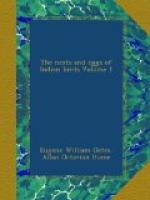“By reason of the roof and walls the entrance to the nest was at one side, but there was nothing that could be called a hole. The roof projected over the entrance, forming a porch.
“Six or eight nests which I have seen of this species were all over water. But the birds are by no means confined to marshy localities.
“Even in the middle of the rains the nests are invariably made of dry yellow grass.
“One nest found in Berar was in a babool bush, where of course there could have been no leaves pierced.”
Mr. E. Aitken writes:—“I have found a good many nests in Bombay, and it breeds in Poona too. My notes only mention two nests with eggs, on the 22nd and 25th August, but I found some much later; and I am almost certain it begins to lay much earlier, if not actually at the beginning of the monsoon, like Orthotomus and Prinia.
“It builds in gardens and cultivated fields, especially in the vicinity of water, and often among plants growing in water.
“The nest is very firmly attached to the twigs of some plant where long grass or other plants completely surround and conceal it. It is usually about 3 foot from the ground. It varies much in size and shape, some being much deeper than others, and some having the top open; others an entrance somewhat to one side.
“I have always found three or four eggs—bright blue, with large irregular purplish-brown blotches and no hair-lines. I should have said that the nest is a bag, very uniformly woven, of fine grass, and never with any lining—at any rate in none that I have ever found. They never use the same nest twice, always building a fresh one even if you only rob without injuring the first. I think they have only one brood in the year, but, like Orthotomus and Prinia, one or two nests are generally deserted or destroyed by some accident before they succeed in rearing a brood.”
Major C.T. Bingham informs us that this Wren-Warbler is a common breeder both at Allahabad and at Delhi from March to September. Builds a neat bottle-shaped nest in clumps of surpat grass, of fine strips of the grass itself, which I have repeatedly watched the birds tearing off. The eggs are lovely little oval fragile shells of a deep blue, blotched and speckled and covered with fine hair-like lines, chiefly at the large end, of a deep chocolate-brown.




